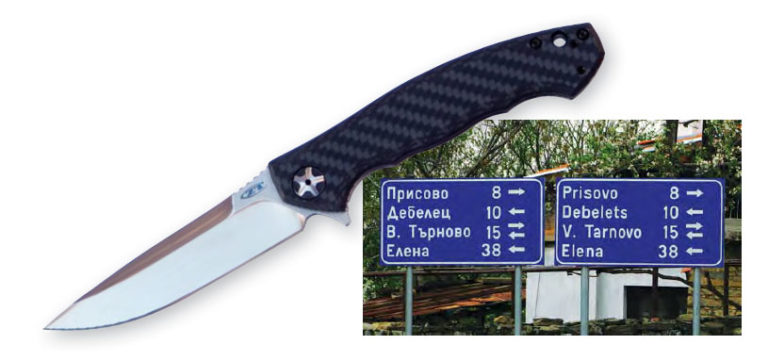
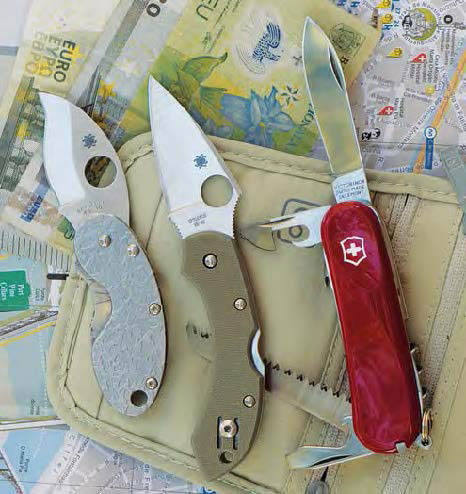
“Can I Bring My Knife to Europe?”
Since I write about travel, and about knives, I receive many emails from readers asking this question. I understand. You always have a knife handy. It’s your basic tool. How do you open packages, or cut anything? How can you get through your day without a knife? What if you need your knife to punch out the window of an overturned bus, or escape from a burning building?
What about that picnic next to the Canal du Midi, or on the train? You don’t want to be reduced to ripping and tearing at salami, cheese and baguettes with teeth and nails. You need your knife. But you don’t know laws and regulations in Europe and you’re a law-abiding person. So can you take your knife with you?
Yes, you can. But there are some things you need to know. In the United States, laws and regulations concerning knives are a confusing patchwork that varies from state to state, town to town, and which sometimes make no sense whatsoever. It is not possible to travel from California to New York with any kind of knife without violating a law or regulation in some place along the way.
Few of those laws and regulations are actually enforced. Enforcement is up to decisions made by an individual police officer. Those decisions will vary from officer to officer, and most importantly, according to his perception of you and the situation.
European Knife Regulations: A Primer
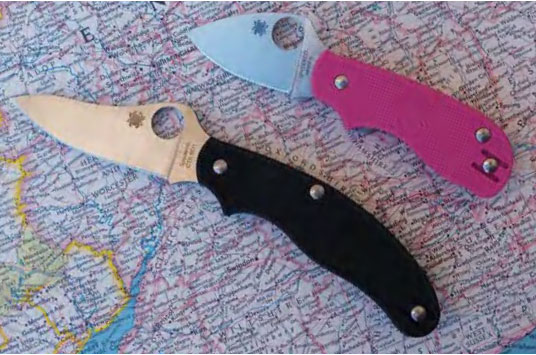
It is similar in Europe. The European Union is made up of almost 30 countries, each with its own laws, customs and regulations, which like in the United States, can seem confusing and senseless. As in the Unites States, enforcement of those laws and regulations is dependent upon the decisions of the individual police officer or security person.
I’ve worked and traveled in Europe for decades, and lived there for the past 10 years. I’ve written for BLADE Magazine and for the KNIVES annual book for almost 20 years, and have written two books on knives: The Tactical Knife and Survival Knives. As a result, I’ve met many folks in the European knife community—knifemakers, bushcraft enthusiasts, and so on.
I know many people who work in the security services and police departments in many European countries, and have talked with them about travelers carrying knives. What follows are my personal experiences and opinions based on traveling and living in almost every country in the European Union, and some that are not members of the Union. I am not a lawyer. I offer no legal advice.
German Knife Laws
Some examples of regulations concerning knives in Europe: In Germany a person may not carry on his person any folding knife with a locking blade. He can, however, carry a fixed blade up to 3½ inches long.
French Knife Laws
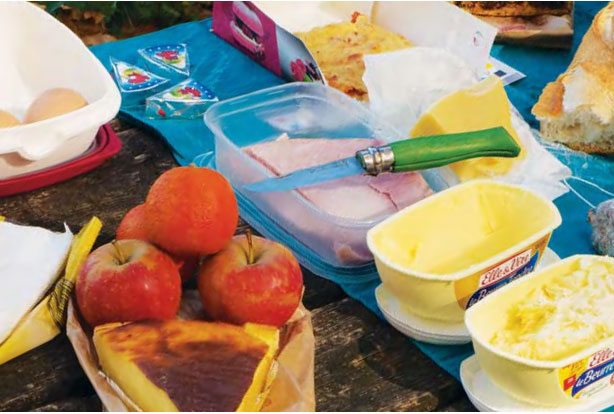
In France a person may not carry on his person any object that can be, or is, used as a weapon. That includes France’s famous Opinel or Laguiole knives, which are national icons and are in the pockets of every third Frenchman.
Spanish Knife Laws

part of an abandoned house in Huescar, Spain.
Spain has considerable history as a knife culture and has knives of all kinds available for purchase pretty much everywhere – including village bars, and a confusing morass of regulations that my friends, who are Spanish police officers, cannot understand or explain.
UK Knife Laws

In the United Kingdom, there was a recent attempt to prohibit chef’s knives from having a point. That regulation did not pass.
My understanding of the current UK laws is that you must have a reason to have a knife, such as being a carpenter. Locking folders are not allowed. Bushcrafters carrying fixed blades while on the way to do some bushcraft seem to get a pass.
Danish Knife Laws
In Denmark a person may not have any folding knife with a blade lock, or that opens with one hand. Wait! That regulation was just changed. Locking folders are OK now, for today.
European Knife Laws by Region
Attitudes about knives also vary by region. Eastern Europe, the Balkans and Turkey are much more liberal about knives than in Western Europe. I’ll delve more into that later.
European Knife Law Tips
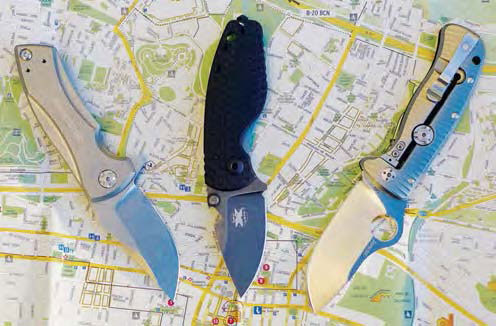
What’s a European traveler to do? How could anyone know or conform to all of the different laws and regulations while traveling through four or five countries? You cannot. So, you have two choices:
- Choose not to carry a knife.
- Use some common sense.
You can stop reading now if you select choice number one.
ML (my wife and companion of many adventures) and I always travel in Europe (and every place else) with knives, carrying at least two each, and often more. We frequently rent holiday apartments and live for a month or so in various places where we shop, cook and settle in to experience local life. The kitchens in those apartments never have usable knives.
Common Sense and European Knife Laws
We also teach survival and bushcraft classes during which we make shelters, primitive tools and so on. During the past year I’ve been attacked twice by feral dog packs in the Balkans. On one occasion I had no stick and my knife was my only defense. Often I’m toting a half-dozen or so knives that I’m reviewing for various publications. We need our knives.
Many Americans we meet traveling in Europe also need their knives, the ones who have knives. In addition to the practical everyday uses of a knife and its indispensable use in disasters, a blade can provide steely comfort in a dark and lonely place, and not only from dog packs.
A young American woman, a solo world traveler I wrote about in my recent book, Essential Survival Gear, used her J.A. Henckels paring knife for daily camp chores while hiking in coastal mountains in Turkey, and was glad to have her little blade one night when a crowd of drunken men made her very uncomfortable.
A retired American who I met in Romania used his Benchmade 710 to cut the fuel line on his BMW motorcycle while doing some repairs, and for frequent picnics, and one dark night to confront two muggers, who then decided to find easier prey. Potentially violent incidents like this are rare. Europe in general is safe for travelers, arguably more so than in the United States. But hey, you never know.
So how do I and other folks travel in and through European countries with knives and not run afoul of the law? We do so by using common sense and being sensible in our selection of knives, and by not doing stupid things such as going to a sketchy bar, getting drunk, hitting on a local girl, and when her boyfriend, also drunk, forcefully objects, waving a knife around and threatening him.
In Spain I saw three guys passing a bottle of wine and a folding knife around, cutting bread and cheese while picnicking at the beach. It was all good, except they were talking loudly, arguing with each other and annoying the folks around them. When one fellow politely objected to their behavior, one of the idiots grabbed the knife, shook it at the follow and yelled, “Allahu Akbar!” Then he collapsed laughing, as did his friends.
This incident didn’t end well. Personal demeanor, behavior and appearance affect how a person is perceived and treated by security people, and everyone else.
Choosing Knives to Bring to Western Europe
As to knife selection, attitudes in Western Europe regarding knives and security have changed considerably in recent years due to many terrorist attacks, some of which have been carried out with knives. As a consequence, although not yet common, there are security checks in some Western European train and bus stations, and of course in all airports.
We’ve never encountered a security check at an Eastern European train or bus station. If you encounter one of these security checks and have a black, 10-inch blade with “Zombie Killer” etched in steel and stuffed into your waistband, it will not endear you to the security people.
When ML and I travel, in Western Europe or elsewhere, we each always have a tiny folder with a locking blade of about 2 inches on our persons and a small fixed blade in our bags. These knives look inoffensive and have caused no alarms with security people, or anyone else. Probably folders with blades a bit larger, single blade or multi-bladed, such as small Swiss Army Knives, would also be seen as inoffensive.
Most regulations address carrying a knife on the person, with knives in bags being considered differently. Security people also seem to see a difference between carrying on your person and in a bag. Maybe not in all instances, but this has been our experience. I’ve never seen a knife in a day bag with bread and cheese and other picnic things, whether my knife or someone else’s, cause scrutiny.
Our tiny folders are for everyday tasks, sometimes including food preparation when we don’t care to get out our fixed blades. ML can girdle a baguette and reduce it to slices in less than a minute with her Spyderco Cricket. My Spyderco Dragonfly will slice salami, cheese, tomatoes and so on about as well as my fixed blade. They will also serve in an emergency, if you know what you’re doing.
These little folders and others in the same size range or a bit larger are convenient everyday carry knives. We use the fixed blades in our kitchens, for field work and in emergency situations. I also carry a small red-handle Swiss Army Knife (SAK) with a locking main blade and the all-important corkscrew. We add to this selection if needed, say, a machete in the tropics.
Our day bags are also our ready bags, or bug-out bags, and are always with us. Our fixed blades have much daily utility and will serve in an emergency, such as having to cut through a locked steel fire door to escape a high-rise fire, serve as a climbing aid to escape freezing water, or fend off a pack of feral dogs.
I’ve done all of these things and know that, if needed, our fixed blades will provide us with a measure of protection.
Western European Security Checks, Police Searches and Knives
We’ve only ever been questioned about our knives during a few security checks. Before boarding a high-speed train in Barcelona, we put our bags through the X-ray machine and walked through the metal detector. One of the security officers asked if I had a knife. I said I did. He asked to see it. I first took out my Spyderco Dragonfly, intending to next get my Fallkniven F1 out of my bag. The security guy looked at the little Dragonfly, smiled, and said, “Oh never mind. It’s so little. Just put it back in your pocket.” He waved us through and said nothing about my F1, or ML’s Sypderco Cricket and Fred Perrin Street Beat.

Clearly, he made his evaluation based on our appearance and behavior, as well as our choice of knives. On another occasion, while disembarking from a bus in Lyon, France, we encountered an intensive security check due to an alert that a terrorist suspect might be on our bus. Results were the same as in Barcelona, as they have been on other occasions. European police, like American police, evaluate the person and the situation when making a decision. We do not appear to be a threat, nor do our knives. When asked, we give a straightforward explanation of why we have knives, and have had no problems.
Carrying Knives in Eastern Europe, the Balkans and Turkey
In Eastern Europe, the Balkans and Turkey, attitudes concerning knives are very different. Full-size tactical folders are popular for everyday carry, and no one seems alarmed by them. Fixed blades that are 6 to 10 inches long are preferred for field activities, hunting, backpacking and so on, and for use in villages to do everyday village things, such as killing pigs and goats.
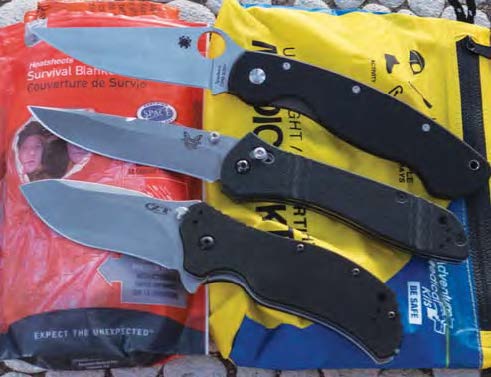
I asked a friend, who is a Bulgarian undercover cop, what the laws were governing carrying knives in Bulgaria, and what the police attitude was. I also explained the regulations in Western Europe. He said, “We don’t concern ourselves with such silly things as that. We don’t care what kind of knife you have. But, if someone attacks and harms another person with a knife, or any weapon, then we do care.”
A former Czech special forces officer now in a civilian security service said much the same thing.
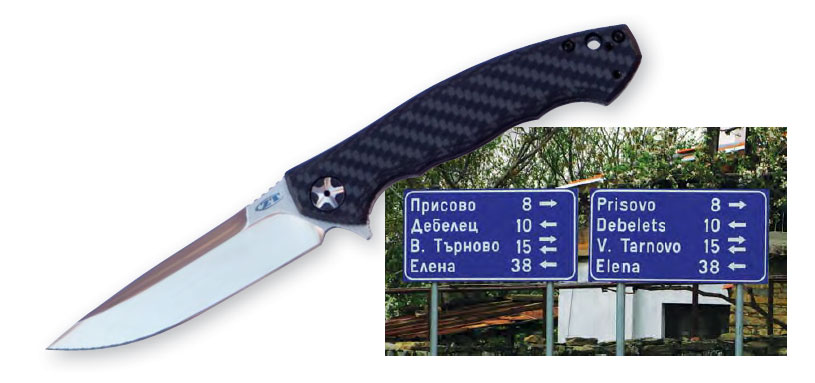
We’ve only been questioned about knives in the East once, at Ataturk Airport in Istanbul. Going through first layer security at the entrance to the airport, I tossed a bag on the counter containing a kindjal, a yatagan, a 10-inch bowie, and a half-dozen or so tactical folders and fixed-blade survival knives, all for field work and photography for articles and books.
The security guy said, “You have quite a few knives in your bag.”
“Yes,” I replied, “I do.”
“You’re going to check them, not carry them on, right?”
“Of course.”
“Have a nice day.”
Obviously we check all knives before boarding a commercial aircraft.
Trust Your Internal Compass
If you like to drink and hang out in sketchy bars and clubs, leave your knife in your room. Don’t try to use your knife as a weapon, except in extreme circumstances when your own life is actually at stake. Doing so is considered lethal force everywhere, and you will have to defend your actions. Again, use common sense. You have an internal compass that points in the right direction. Pay attention to it. This approach has worked for us. Your results may vary. No guarantee is offered or implied.
Get the Most Out of Your European Trip
Before your trip, use the Internet to locate knife shows. There are many all over Europe. Attend one.
Perhaps visit one of the famous knife-producing towns: Thiers, France; Solingen, Germany; and Maniago, Italy. You’ll meet friendly people with a common interest. Do go. You’ll have a great time. Bon voyage.
Keep Learning About Knife Laws — in the United States
Read more:
 NEXT STEP: Download Your Free KNIFE GUIDE Issue of BLADE Magazine
NEXT STEP: Download Your Free KNIFE GUIDE Issue of BLADE Magazine
BLADE’s annual Knife Guide Issue features the newest knives and sharpeners, plus knife and axe reviews, knife sheaths, kit knives and a Knife Industry Directory.Get your FREE digital PDF instant download of the annual Knife Guide. No, really! We will email it to you right now when you subscribe to the BLADE email newsletter.


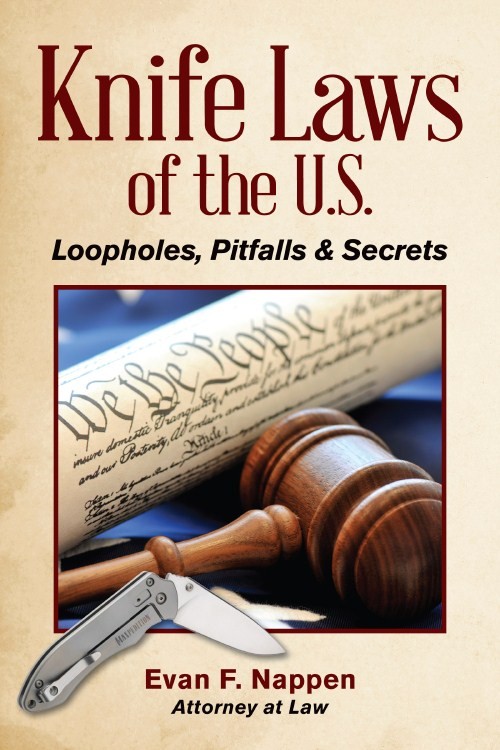





Copied on the police’s website and Google translated a bit about what applies in Sweden. “It is forbidden to have knives, stabbing weapons, cutting weapons and other dangerous objects in a public place, within school grounds or in a vehicle in a public place unless the possession is justified. The prohibition applies to objects that are intended to be used as weapons in crimes against life or health. ”
“Examples of exceptions to the ban:
(when can possession be considered justified)
Military carrying knife for uniform
Craftsman using knife at work
Mushroom pickers who carry a suitable knife during hiking”
If you are traveling in Europe, take the opportunity to visit one of the knife events. On the European Blades website there is a list of some ( http://www.europeanblades.com ). As I work with Knife Expo 2024, Vadstena, Sweden, I know how much fun it is with long-distance guests. Therefore, I welcome everyone both to us and to all other events.
I wish that had been my experience flying in Turkey! I bought a beautiful Turkish dagger with a Damascus steel blade and a carved wooden horse head as the hilt at the Grand Bazaar, and an airport security officer confiscated it for being “too sharp” — even though of course I was checking it, not attempting to carry it on. He really just stole it but I had no recourse to get it back.
You are completely wrong for Germany. For normal daily carry :-
Fixed blade knives up to 12cm are allowed except daggers and karambits (knives specifically classed as weapons by law or by the federal police BKA).
Locking (and of course non-locking) folding knives have no restriction on size at all as long as they do not have any kind of one hand opening aid.
Other knives not allowed as daily carry are allowed with good reasons such as the massive daggers used by hunters which otherwise fall in the weapons category.
Heathrow City Transfer is your ideal solution if you’re concerned about traveling from the airport to your final destination during your visit to London. They are a professional company specializing in airport transfers and port transfers for cruises.
The short summary of German laws near the beginning are false.
GERMAN KNIFE LAWS: LEGAL CARRY
Knives that can be legally possessed and carried:
Fixed blades with blade length under 12 cm (4.72 in.) can be carried visible or concealed. The measurement is taken from the tip to the most forward parts of the scales, the length of the sharp edge is not important.
Folding knives that can be opened with one hand and do not lock the blade.
Folding knives that ca be opened with two hands only and lock the blade.
I will be in Switzerland this summer and want to buy some knives while there. Will they cause a problem in my carry on or should I have them shipped?
To leave certainly no problem, the knives offered in stores are legal to buy and carry in Switzerland. Exceptions are automatic knives, butterflys, fixed daggers, but these are not offered. Klotzli in Bern is a good adress.